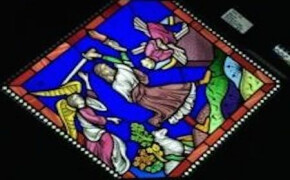Incarnation to Install Spectacular Stained Glass Window

The creation of a stained glass window for a church in Dallas has brought giddy excitement to theologians and glassmakers across the globe.
Church of the Incarnation commissioned a team of glaziers to make a stained glass “salvation” window that is inspired by 13th Century stained glass at the Canterbury Cathedral in England. The new window is scheduled for installation in late March and dedication is scheduled for 10:20 a.m., March 26.
This window is emblematic of the Church of the Incarnation’s program to introduce men and women to the true and the good through the beautiful, said the Rt. Rev. Tony Burton, rector.
A team of specialists has been working on the medieval-style window for the last two years. The project, which is based on Canterbury’s Redemption window in the Corona has been undertaken by the Stained Glass Studio at Canterbury to offset the cost of conserving the Cathedral’s own historic glass. The project was so challenging for the experienced conservators that the newly created window has become a big deal in England with national news coverage and a public viewing before it is shipped to Dallas for installment.
The first challenge came in determining how to tell the same Biblical stories in different window shapes. Unlike Canterbury, the Incarnation window has three narrow, arched panels with three rosaries on top. The final product offers fifteen different Biblical images to provide a way of reading and interpreting the work of Christ and the Bible. Clergy plan to use the window to illustrate Bible stories for young members of the congregation and to photograph sections to display on large screens during services.
It was important to Incarnation that the design pay homage to the original window, said Director of the Stained Glass Studio Leonie Seliger. “This was a massive undertaking because the windows here were produced by the greatest stained glass artists of the time so to replicate their work would require an incredible amount of talent and skill,” he said. “We wanted to make sure it would be as true to the original as possible, not only in the design but in the iconography and stories. I had long phone calls with their theological adviser about the exact content of the cartoons, different attributes and colors. It occurred to me this is the same conversation that would have taken place 800 years ago between the Prior and the Glazier – it was as if the distance in time collapsed upon itself.”
Areas of Canterbury’s Redemption window have been damaged and replaced over the centuries so to be true to the medieval period, the design of elements – as intricate as faces and wings – had to be borrowed from other medieval glass in the Cathedral and even from France.
Other aesthetic challenges meant artists had to work around regulations in Dallas requiring new public buildings to include a special energy saving glass on windows. This outer layer of glass has a greenish-brown hue, which meant the artists had to figure out how to counter that dull pigment when coloring the stained glass. Glassblowers also had to learn how to reproduce glass similar to that in the 13th Century that had varying degrees of thickness, so the window would refract light more beautifully than the current, smooth processes. We “asked them if it was possible to recreate those lovely variations that you can see in the original medieval glass. And they did. It meant a lot of unlearning for them and some trial and error, but eventually they managed to un-refine their process and produce this marvelous glass,” Seliger said.
The final product is probably closer to the original work of medieval stained glass than the current Canterbury window. “We did not artificially age the new work, so what you see now is very close to what the windows in Canterbury Cathedral looked like 800 years ago – before surface corrosion and repairs changed their appearance significantly,” Seliger said. “The completed Dallas window contains a huge number of tiny pieces of glass, more pieces than any other window we have produced in my time here. It was a very ambitious project and one that every member of the stained glass workshop was involved in.”
The stained glass is an important hallmark to the continued mission of sharing the Gospel, Burton said. "The window both celebrates the union of the divine and human in Christ and invites us to consider that the Christian life involves nothing less than our coming to share in the divine life through our union with the Lord Jesus."
The Canterbury Cathedral and Church of the Incarnation contributed to this article.

